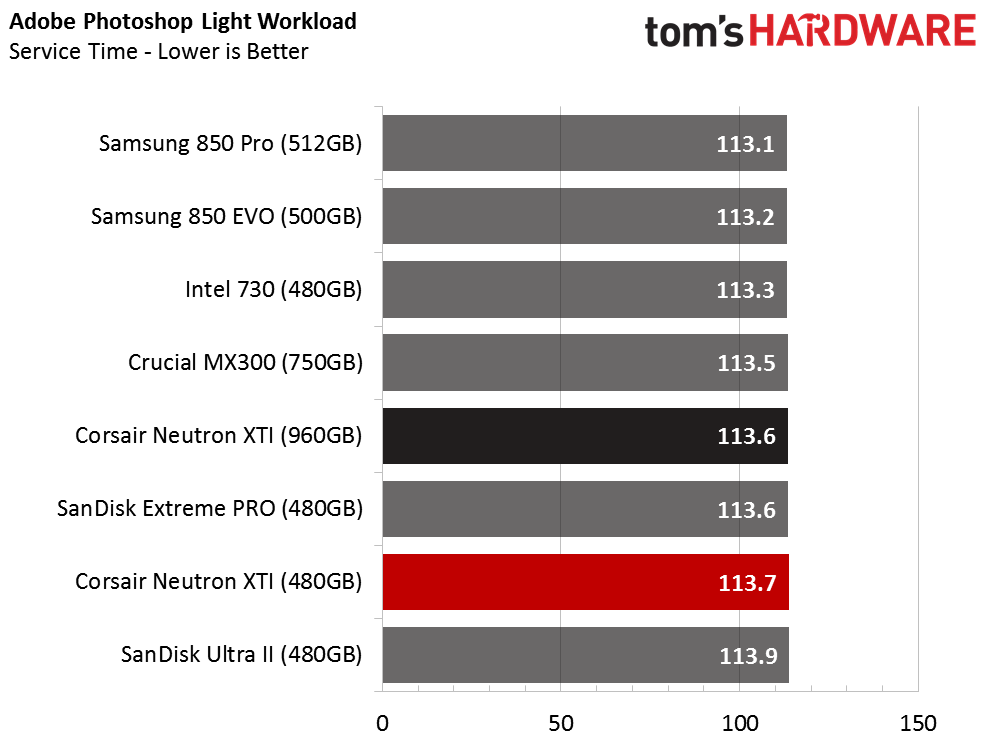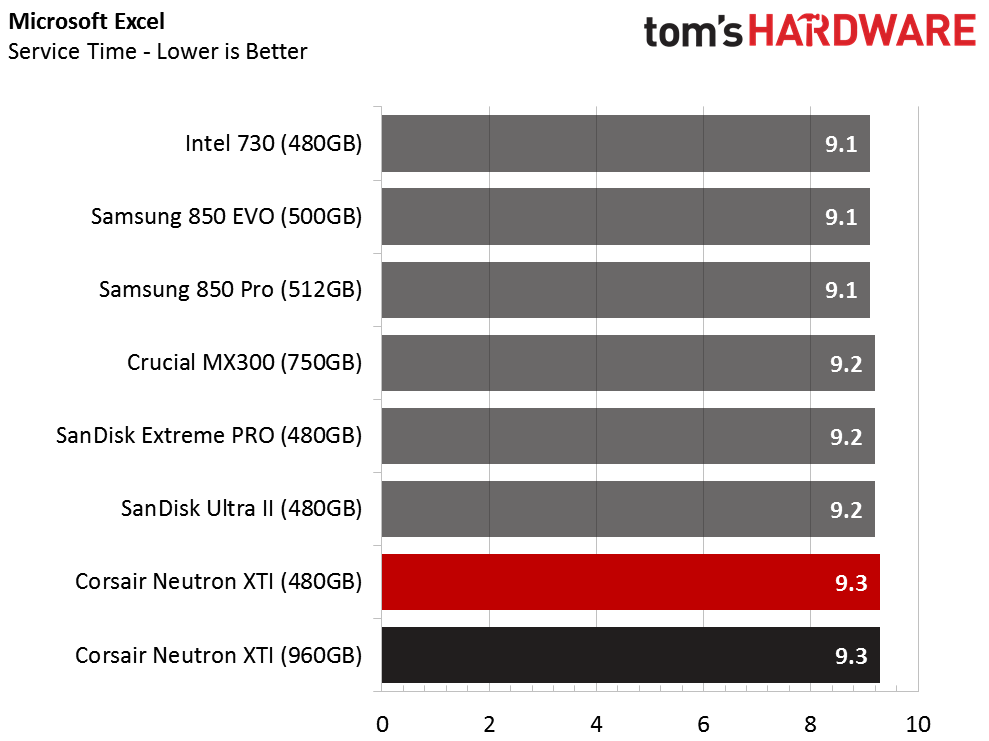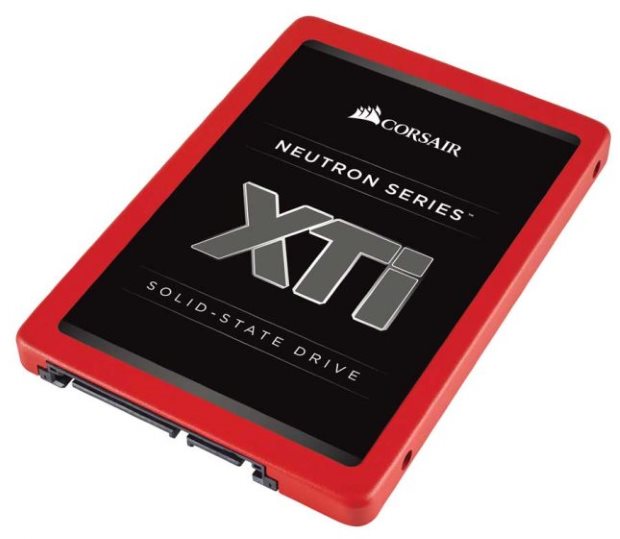Corsair Neutron XTi SSD Review
Why you can trust Tom's Hardware
Performance And Conclusion
PCMark 8 Real-World Software Performance
For details on our real-world software performance testing, please click here.










There is no doubt that Corsair and Phison have increased the performance of the S10 controller in the Neutron XTI. However, all of the performance gains have come in workloads that users will rarely see under normal use, such as at high queue depths or in extreme steady-state conditions.
Throughput Storage Bandwidth
The XTi does not improve desktop performance by a significant margin over other Phison S10 MLC-based products, such as the HyperX Savage (231 MB/s). The Zotac Premium Edition 480GB (261 MB/s) even performed slightly better in our testing, and it is approximately $10 less than the Neutron XTi 480 GB.
PCMark 8 Advanced Workload Performance
To learn how we test advanced workload performance, please click here.



The previous set of tests utilize light workloads. The Corsair Neutron XTi performs much better compared to the other products once users turn up the heat. We often see this tendency with many enterprise SSDs, which have firmware tuned specifically to deliver superior performance during heavier workloads. The Neutron XTi delivers impressive performance under heavy use, but you shouldn't expect best-in-class performance during all workloads.
The drives perform nearly identical to the Samsung 850 Pro 512 GB (dark purple line) under heavy workload conditions.
Total Service Time



The Neutron XTI provides much better service times than the Samsung 850 Pro does. It also matches, and even surpasses, the SanDisk Extreme Pro 480GB at various points in the test. The low latency, again under heavier workloads, shows the increased performance that additional DRAM can bring to a consumer SSD.
Get Tom's Hardware's best news and in-depth reviews, straight to your inbox.
Notebook Battery Life


We did not use the same products we used in our previous notebook battery life charts. We are still working our way through SSDs on our new Lenovo Y700 17-inch test platform, which allows us to test SATA and PCIe NVMe products in the same system. This product selection does give you a glimpse of some of the SSDs coming up for review.
The Corsair Neutron XTi SSDs deliver average battery life performance in our notebook test. 340 to 360 minutes is right in the middle of the approximately 30 SSDs that we've tested thus far.
We updated our test software when we upgraded the test platform. MobileMark 2014 version 1.5 expands the performance-on-battery portion of the test to provide us with more detail on the differences between the SSDs. The Neutron XTI SSDs both fall into the top performance tier when using battery power.
Conclusion
The Corsair Neutron XTi is a mixed bag when it comes to performance, and this isn't the first time we've seen this type of behavior in a premium SSD. The XTi reminds us of the Samsung 850 Pro in many ways. Not only is the performance similar, but both are top-tier products that work better under heavy loads - and most shoppers will overlook them both.
The Samsung 850 EVO is still the best SSD for consumer workloads and value. Most of our readers shopping for a new SSD will (and should) pick the 850 EVO. SSDs with large pSLC buffers tend to utilize the fast single-bit cache to absorb small random writes better than MLC-based SSDs.
That said, if most of your workload involves heavy sequential data writes, the Corsair Neutron XTI is a good option. The XTi series brings an enterprise feel to heavy workloads, and the SSD really shines brightest when it is pushed with heavy sequential data writes. It also excels during mixed sequential workloads, which tax the controller with simultaneous read and write operations. The XTi's preference for high-queue depth workloads is similar to a car with a minimum speed of 100 miles an hour. Unfortunately, in the real world, sometimes we have to drive around the city and stop at stoplights.
The Phison S10 controller has struggled with random small block performance since its release. Phison and its partners continue to address the challenges with tricks that seem to help, but each incremental increase comes in small doses. The fixes appear to skirt around the issue instead of directly attacking the actual problem, which is the subpar random read performance. The low read performance punishes the S10-powered SSDs in more complex mixed read/write workloads.
The Corsair Neutron XTI is destined to have the same effect on the market as the Neutron XT: None. Corsair has positioned this drive as a premium product, but in reality, for most typical workloads the XTI can't outperform some of the products in the mainstream category. Its five-year warranty also pales in comparison to the prodigious 10-year warranty periods found with some competing SSDs.
Corsair will have to play the pricing game to gain market share with the Neutron XTi, and the company will likely have to sell it for less than the Samsung 850 EVO. The 512 GB and 1 TB capacities we tested today both have 850 EVO-like pricing now. The 850 EVO SSDs cost a little less, but once the early adopter tax subsides we suspect the Neutron XTI series will sell for less. At that point, you can take a serious look at this product and decide how much the random read deficit is worth to you.
Follow us on Facebook, Google+, RSS, Twitter and YouTube.
MORE: Best SSDs
MORE: How We Test HDDs And SSDs
MORE: All Storage Content

Chris Ramseyer was a senior contributing editor for Tom's Hardware. He tested and reviewed consumer storage.
-
Kimonajane Too expensive still. Better having a smaller SSD for programs and using big platter drives for storage. I don't know why the average Joe needs so much storage anyway. I guess if you digitally download movies or take many high resolution pictures. There is where cheap platter drives still win. Use one always for backup too.Reply -
Sakkura High-end SATA SSDs have been a little pointless (for consumer use) for a long time, but it's only getting worse as PCIe storage proliferates. Right now, 99.9% of people should either get an affordable mainstream/budget SATA SSD, or if they really need the speed, go for an M.2 PCIe (or U.2 or PCIe AIC) SSD. If you're gonna pay for a premium product, you might as well go for what's actually considerably faster across the board, rather than this kind of half measure.Reply -
chalabam Most drives are now bottlenecked by SATA.Reply
And because a lot of people cannot change the motherboard to get no SATA drives, SATA drives should come with multiple parallel SATA connectors, and a software driver capable of using them to extract more speed out of the SATA interface. -
chalabam Most drives are now bottlenecked by SATA.Reply
And because a lot of people cannot change the motherboard to get M-2 or fancier, SATA drives should come with multiple parallel SATA connectors, and a software driver capable of using them to extract more speed out of the SATA interface. -
Sakkura Reply18326906 said:Most drives are now bottlenecked by SATA.
And because a lot of people cannot change the motherboard to get M-2 or fancier, SATA drives should come with multiple parallel SATA connectors, and a software driver capable of using them to extract more speed out of the SATA interface.
No point, simpler to just run them in RAID0 if you need more speed. -
deus You'll be interested to kno none of the charts display in FF 47.0.1 and the same applies to the review of the SK hynix .Reply
Charts do show in IE 11.
Nice.
Lets earn money anyway we can, eh ?

